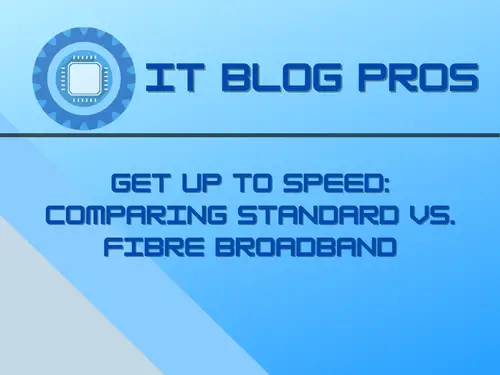If you’re in the market for a new broadband provider, you may be wondering what the difference is between standard and fibre broadband and which option is right for you. In this article, we’ll compare standard and fibre broadband coverage, speeds, and reliability to help you make an informed decision.
We’ll also explore the availability of landline-free broadband options for those who have made the switch to using mobile phones exclusively. By the end of this article, you’ll have a better understanding of your broadband options and be able to find the right package for your needs.
Table of Contents
- What is broadband and how does it work?
- Comparing standard and fibre broadband: coverage, speeds, and reliability
- Landline-free broadband options for mobile phone users
- UK broadband speeds compared to other developed countries
- Find the best broadband deals for your needs on itblopros.com
What is broadband and how does it work?
Broadband is a type of high-speed internet connection that enables users to access the internet more quickly and reliably than with traditional dial-up connections. Instead of using a phone line to connect to the internet, broadband uses a variety of technologies to transmit data, including cables, satellite, and wireless networks.
There are two main types of broadband: standard and fibre. Standard broadband uses ADSL (Asymmetric Digital Subscriber Line) technology to connect to the country’s existing copper phone network, which means it is available in most parts of the UK. However, the availability of standard broadband comes with a reduction in speeds, including slower download times. Standard broadband’s average download speeds are around 10 to 11 megabits per second (Mbps).
On the other hand, fibre broadband refers to the use of fibre-optic cables to connect to the internet and transmit data. This leads to much faster data transfer speeds, resulting in a quicker internet connection for both downloading and uploading. Fibre broadband also offers a more reliable service, as fibre-optic cables are less prone to degradation than copper wires. However, not all parts of the UK have access to fibre broadband, although efforts are being made to connect the entire country
| Feature | Standard Broadband | Fibre Broadband |
|---|---|---|
| Coverage | Widely available across the UK | Limited availability; expanding coverage |
| Speeds | 10-11 Mbps (average) | Up to 1,000 Mbps or more |
| Reliability | Copper wires prone to degradation | Fibre-optic cables less prone to degradation |
| Landline requirement | Yes | Yes (for most providers) |
Comparing standard and fibre broadband: coverage, speeds, and reliability
When choosing a broadband provider, it’s important to consider the coverage, speeds, and reliability of the service being offered. Standard broadband is widely available across the UK, thanks to its use of the copper phone network. However, its speeds are generally slower than those of fibre broadband. Standard broadband’s average download speeds are around 10 to 11 Mbps, while fibre broadband can offer speeds of up to 1,000 Mbps or more.
Fibre broadband is not yet available to all parts of the UK, but its coverage is expanding. Currently, about 80-90% of the UK is covered by BT fibre, and 60% is covered by Virgin Media’s dedicated fibre network. It’s easy to check whether fibre broadband is available in your area by entering your postcode into the website of any internet service provider (ISP).
In terms of reliability, fibre broadband is generally considered to be more dependable than standard broadband. Copper wires are prone to degradation over time, which can lead to a drop in the quality of the broadband connection. Fibre-optic cables, on the other hand, are much less prone to degradation and can provide a consistently high-quality connection.

Landline-free broadband options for mobile phone users
While most broadband providers require a landline to deliver their service, some ISPs offer landline-free packages for those who have made the switch to using mobile phones exclusively. These packages use alternative technologies, such as cable or satellite, to connect to the internet.
However, it’s worth noting that landline-free broadband options may not be as widely available as those that require a landline and may also come with slower speeds and less reliable connections.
UK broadband speeds compared to other developed countries
According to a recent report, the UK ranks 44th in the world for average internet speeds among developed countries. While most everyday users may not notice a significant difference in their internet speeds, this ranking may be a cause for national pride. However, it’s worth noting that the UK has made significant progress in expanding its broadband coverage and increasing speeds in recent years.
Find the best broadband deals for your needs on itblopros.com
When shopping for a broadband provider, it’s important to compare deals from a range of providers to ensure you’re getting the best value for your money. At itblopros.com, we offer a range of broadband deals from top ISPs, so you can find the right package for your needs and budget. Whether you’re looking for standard broadband, fibre broadband, or a landline-free option, we’ve got you covered.
Visit itblopros.com today to compare the best broadband deals and start enjoying fast, reliable internet access for all your online needs.
I hope this blog post helps to provide a clearer understanding of broadband, the differences between standard and fibre broadband, and the options available to mobile phone users. Thank you for the opportunity to write on these topics! Let me know if you have any questions or need further clarification on any of the points covered.


